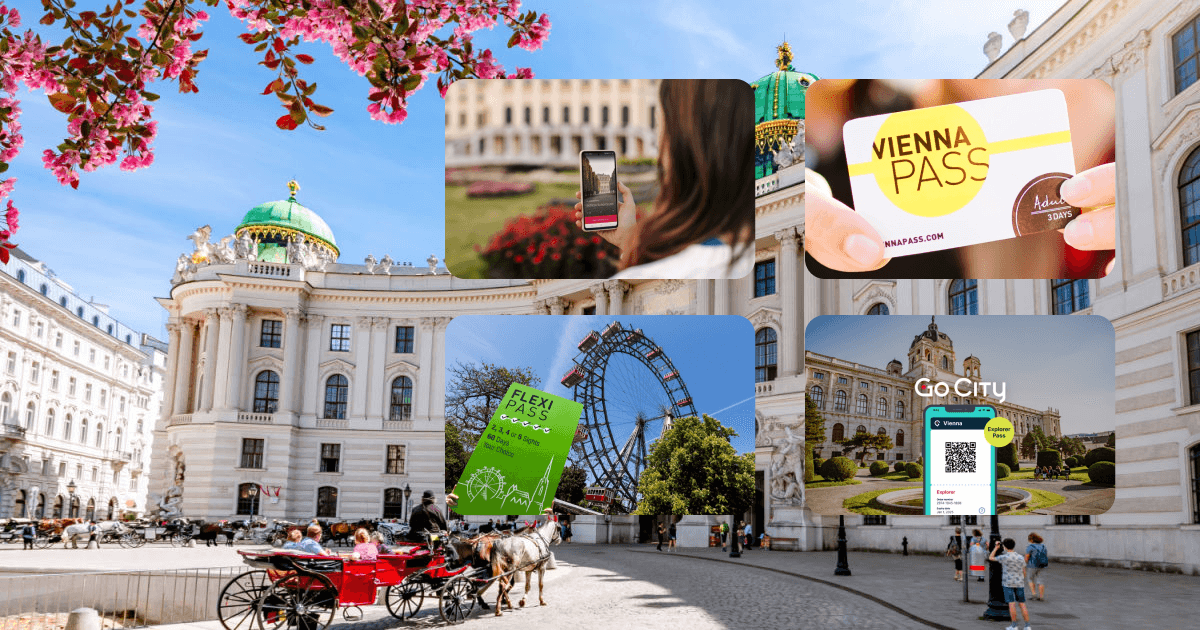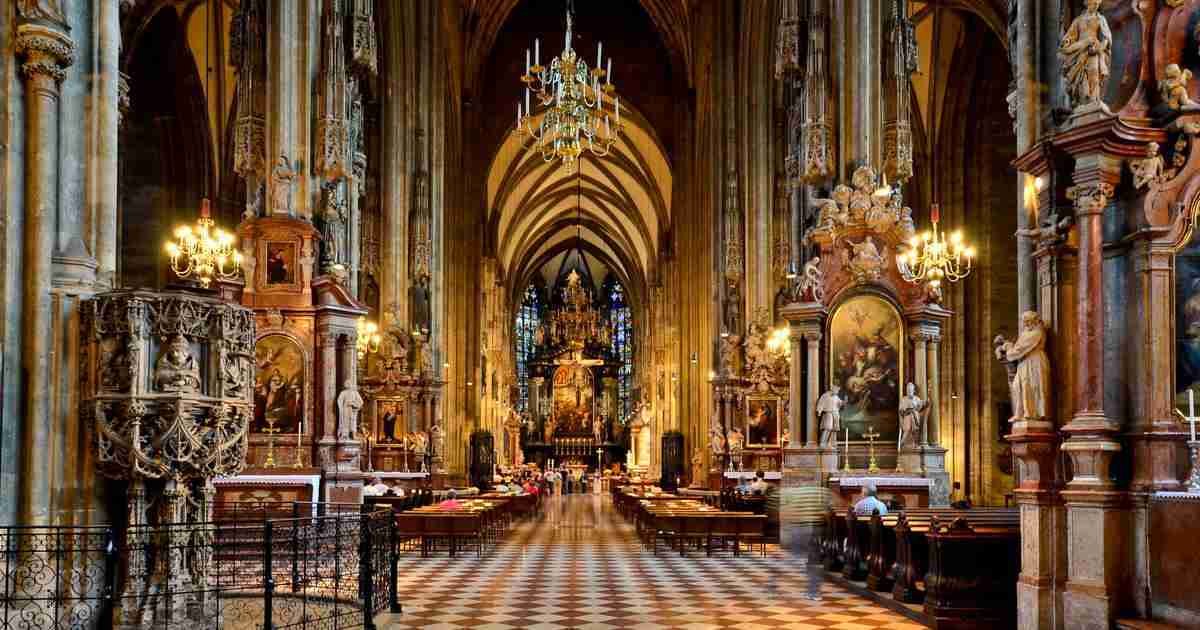St. Stephen's Cathedral is the center of Vienna.
It stands in the middle of the first district, which was once surrounded by the city walls, and thus forms the heart of old Vienna. Affectionately called Steffl by the locals, the Cathedral is one of the city's landmarks.
In addition to the breathtaking architecture, where the patterned tiled roof and the 136 m high south tower stand out, the mother church of the Roman Catholic Archdiocese of Vienna also impresses with its cathedral treasure, the best view in the old town and the catacombs in which the bones of Habsburg dignitaries rest.
Admission to the rear of St. Stephen's Cathedral is free, but the catacombs, north and south towers can only be visited for an entrance fee.
In the following, we will go into all the important points in more detail. Let's go!
Other Recommended Articles:
Ticket Options for the St. Stephens Cathedral
With numerous websites offering tickets for the St. Stephens Cathedral, it can be difficult to choose the right tickets. That's why we've taken the time to compare all the available options for you.
Below, you'll find a curated list of the most popular and cheapest ticket options for the St. Stephens Cathedral. Simply click on your preferred choice to purchase your tickets.
What Can I See in St. Stephens Cathedral?

Admission to the back of the cathedral is free. However, before entering the interior of the cathedral, take a look at the ornate Romanesque-style front door called the Giant 's Gate. It owes its name to the leg bone of a mammoth that hung there for decades in the 15th century. Along with the two heathen towers that flank the gate, it forms the oldest part of the cathedral church.
The breathtaking interior that has changed over the centuries. You can explore on your own or on a public cathedral tour. 30-minute cathedral tours are offered daily for a fee.
Countless architectural details are hidden inside the cathedral. The early baroque high altar, which shows the stoning of Saint Stephen, is particularly worth seeing. This dates from the 17th century and was built in a 7-year construction phase. Another 17 altars are located on the side aisles and pillars, some of them date from the High Middle Ages.
You can also admire the masterly pulpit, the medieval stained-glass windows behind the main altar and the numerous small chapels, of which St. Valentine 's Chapel and the Baptistery are particularly noteworthy.
The highlight, however, is the spectacular cathedral treasure of St. Stephen, which consists of over a hundred valuable relics, numerous sacred painting masterpieces, works of art made of gold, silver and precious stones, sculptures, paintings and much more.
You can also enjoy a magnificent view of the cathedral church. Interested parties can visit the cathedral treasure in the cathedral museum for a fee. This is in the west gallery, on the two upper floors above the entrance to the church.
Tomb of Emperor Friedrich III
Also hidden inside the cathedral is the magnificent tomb of Emperor Frederick III, who, with a reign of 53 years, was the longest reigning head of the Holy Roman Empire. The impressive tomb made of a red, marble-like stone is decorated with 240 statues and is considered a major work of the late Gothic period.
Scientists have only recently been able to examine the interior of the tomb, the last untouched imperial tomb in Europe, which was rumored to be empty. The investigation turned out to be a sensational find: in addition to the corpse of the emperor, the researchers also found a crown, a scepter, an orb, a sword, a large crucifix and more.
Catacombs
You should also not miss the catacombs under St. Stephen's Cathedral. These can only be visited for a fee and as part of a public tour.
In the ducal crypt are the urns of the Habsburgs, in which the entrails of members of the ruling family were buried. Among others, the Habsburg Duke Rudolph IV, the founder who laid the foundation stone for the new church in 1359, rests here.
In the underground labyrinth, however, not only numerous well-preserved bones and entrails of well-known Habsburgs are buried, stacked bones of countless victims of the plague also rest in the crypt.
The last resting place of numerous Viennese cardinals and archbishops is in the bishop 's crypt.
South Tower "Steffl"

Of the four towers of St. Stephen's Cathedral, the south tower is the tallest at 136.44 meters. It dominates the silhouette of the city unlike any other building.
Climbing the 343 steps is definitely recommended despite the effort, because Steffl is the best lookout tower in the old town. The tower ascent leads to a height of 72 meters in the tower room, where you can enjoy a spectacular view of Vienna.
- Note: There is an entrance fee to climb the South Tower.
North Tower with Pumerin Bell
The north tower of St. Stephen's Cathedral, also known as the Eagle's Tower, can be reached by elevator. However, the 68.3 meter high tower was never completed.
Numerous legends are entwined around the unfinished tower. The most famous legend says that the master builder, Hans Puchsbaum, was just an assistant at the time of construction and made a pact with the devil to complete the construction of the north tower within a year. On the other hand, a probable reason for the unfinished construction is the approaching Turkish threat at that time and economic problems.
In addition to the wonderful panorama, visitors to the north tower can also expect the largest church bell in Austria: Pummerin Bell. The bell, which weighs around 20 tons, is not only the largest but also the most famous of the 23 bells in St. Stephen's Cathedral. At the same time, it is the second largest free-swinging bell in Europe.
It owes its nickname to the deep sound, which, however, can only be heard on high holidays and special occasions. Also interesting is the fact that the Pummerin Bell was cast in part from abandoned cannonballs from the second Turkish siege of Vienna.
- Note: A fee is also charged for the elevator ride to Pummerin Bell in the north tower.

How to get to St. Stephen's Cathedral?
- By subway:
Lines U1 and U3 to Stephansplatz and a 2-minute walk
Line U4 to Schwedenplatz and 8 minutes on foot - By tram:
Lines 1, 2, 62, 71 and D to stations Oper/Karlsplatz and 9 minutes on foot
Line 2 to Schwedenplatz and 8 minutes on foot - By bus:
Lines 1A, 2A and 3A to Stephansplatz and 1 minute on foot
Timetables:
Subway lines U1, U3, U4
Tram lines 1, 2, D, 62, 71
Bus lines 1A, 2A, 3A
Vienna Network Maps:
High-Speed Connections
Inner Core Zone Vienna
The most popular and best-selling tickets for Vienna
Planning to stay a bit longer in Vienna and explore more of the Austrian capital? We have compiled a list of the most sought-after tickets according to the popular ticket portals GetYourGuide, Headout and Tiqets. Simply click on the description of the ticket that interests you to secure your favorites.
- Skip-the-Line Ticket for Schönbrunn Palace and Gardens + 2-hour Guided Tour in English, Spanish or Italian
- Tickets for the Training at the Spanish Riding School
- Skip-the-Cashier-Desk-Line Ticket for a Ride on the Vienna Giant Ferris Wheel
- Tickets for Vivaldi's Four Seasons concert in Karlskirche
- Tickets for a Hop-On Hop-Off Sightseeing Tour: 24, 48 or 72 hours
- Skip-the-Line Ticket for Schönbrunn Zoo
- Ticket for the Upper Belvedere, including Klimt's Kiss and the Permanent Collection
- Tickets for Belvedere Palace: Lower Belvedere and other Ticket Options
- Albertina: State Rooms, Permanent Collection Batliner, Temporary Exhibitions
- Entrance Ticket to the Kunsthistorisches Museum in Vienna
- Tickets for the Museum of Illusions

Concerts in St. Stephen's Cathedral
With its breathtaking acoustics, St. Stephen's Cathedral is also the venue for grandiose concerts. Attending a classical concert in one of Vienna's best sound rooms is a unique experience for many.
Mass in St. Stephen's Cathedral
There are regular masses in St. Stephen's Cathedral, which you can attend. Dates of the current masses can be found on the homepage of St. Stephen's Cathedral.
History of St. Stephens Cathedral
St. Stephen's Cathedral looks back on almost 700 years of history. The present Romanesque and Gothic form of the cathedral was largely initiated by Duke Rudolf IV (1339–1365) and stands on the foundations and ruins of earlier churches. The first documented mention of the previous buildings goes back to the year 1137.
The Steffl has been the official cathedral church since 1365. In 1433, master builder Hans Prachatitz completed the south tower, which was the largest church tower in Europe at the time. Almost 20 years later, the cornerstone for the north tower was laid. Since 1469 the church has been a cathedral and thus the seat of a bishop, and since 1723 it has been the metropolitan church of the Archbishop of Vienna.
Over time, St. Stephen's Cathedral withstood numerous adversities, such as fires, French wars and Turkish sieges. The sacred building survived almost 800 years almost intact. But in the final weeks of World War II, the cathedral experienced the most massive destruction in its long history. After the devastating fire that raged in the church from April 11 to 13, 1945, the cathedral seemed lost. Numerous art treasures, bells, the organ, the imperial oratory and the Gothic choir stalls fell victim to the fire.
However, the love of the Viennese for its landmark quickly led to the reconstruction of St. Stephen's Cathedral. Numerous donations guaranteed the financing for the reconstruction. On April 26, 1952, just seven years after the fire, St. Stephen's Cathedral was reopened.

Traveler's Tip: City Passes for Vienna
Vienna offers several appealing city passes for travelers that can help you save money and time. We highly recommend purchasing one of these cards.
To learn more about the popular tourist cards, including prices and included activities, check out our article "Best City Pass for Vienna: Compare Prices & Included Activities". Alternatively, you can easily compare and purchase the card of your choice by clicking on one of the buttons below the following brief descriptions.
1. Vienna City Card
The Vienna City Card is available for 24, 48, or 72 hours, providing discounts at 200 attractions, museums, restaurants, theaters, and stores. Additionally, it offers unlimited and free use of public transportation.
2. Vienna Pass
The Vienna Pass is available for 1, 2, 3, or 6 days and grants you free admission to over 60 attractions in Vienna. It often allows you to skip the queues.
3. Vienna Flexi Pass
The Vienna Flexi Pass allows you to choose your favorite 2 to 5 attractions from a selection of over 40 options. You can visit them for free and, if available, enjoy fast-track admission.
4. Go City Explorer Pass
The Go City Explorer Pass enables you to choose your favorite 2 to 7 attractions from over 40 options in Vienna. You can visit them for free and, if available, enjoy fast-track admission.
Address & Map
Address: Stephansplatz 3, 1010 Vienna

